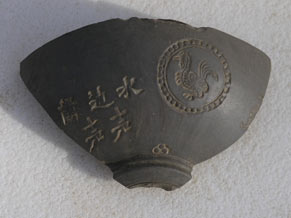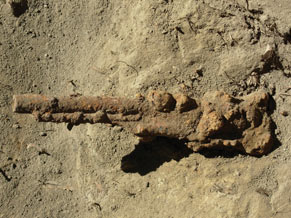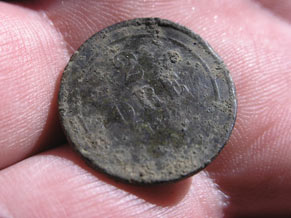Archaeologists dig
Into Sandpoint’s past
Story by Sherry Ramsey
Photos by Jean Plaster and Coutesy CH2M Hill
Sandpoint has a colorful history, not all of which is highlighted in the town’s historical writings. There are gaps in the story of how Sandpoint got where it is today – across Sand Creek from where it started.

This opium pipe bowl was found in an earlier phase of excavation in “Chinatown.” |
|
The approval of the Sandpoint bypass has brought archaeologists from all over the Northwest to do some digging around in “old” Sandpoint. According to Bob Betts, archaeologist and owner of Vanguard Research in Sandpoint, projects using federal money or permits where there is reason to believe cultural resources may be impacted require mitigation, thanks to the National Historic Preservation Act of 1966.
“In this case, the highway bypass, a bridge, on-ramps, storm water ponds, and all kind of things,” said Betts. “Because there’s ground disturbance involved, the state archaeologist down in Boise has to make a determination of whether cultural resources will be impacted by the project. If they decide it will be, they have to come up with a mitigation plan, a resource design that’s approved by the state and other agencies involved.”
In 2005, excavation began in Sandpoint on the largest project Idaho has ever undertaken for archaeological and cultural resources, what will eventually cost $5 million to $6 million for excavation, analysis and reports – funded through the Federal Highway Administration. Initially, the state anticipated a much smaller mitigation program, until local historians argued that this had been a major townsite and because of the fill protecting it, they expected a lot of discoveries.

Turtle figurines, possibly from a bracelet, were found in the area nicknamed “Chinatown.” |
|
“It was very controversial for quite a while,” said Betts. “Finally the state was dragged kicking and screaming, or, should I say, they were eventually convinced into a much more comprehensive archaeological project.”
Last fall the U.S. Army Corps of Engineers issued a water quality permit, a major coup for the continuation of the project.
“The clean water permit is important because a lot of the work we’re doing is at or below the water table, and as we remove vegetation, there’s a potential for runoff erosion into Sand Creek,” said Betts. “All along it’s been a critical aspect of the project, not to have any runoff occur into the creek. We’re screening a lot of sediment and producing a lot of back dirt.”
In 1882, the Northern Pacific Railroad came through here and the original Sandpoint grew up on both sides of the tracks. According to Betts, there were hotels, saloons and various merchants, but it was a narrow peninsula with a lake on one side and a creek on the other. The town was getting too big with no room to expand, and major fires in the late 1800s and early 1900s had destroyed much of it.

1861 Colt revolver was found in the area nicknamed “Chinatown.” |
|
Around 1904 the present location of the town was surveyed and platted by L.D. Farmin on the west side of Sand Creek, which drew most of the property owners and commercial establishments across the creek.
Sandpoint had a reputation early on of being a rough town, with an abundance of railroad people and miners; single men whose boredom led them to saloons, gambling and brothels. Few respectable women resided here until the town was platted.
“Women started moving in, and they built a school and churches and things,” said Betts. “They decided they didn’t need the ‘bad’ element of town and forced them to move back across the creek to the old townsite, calling it the Restricted District. That’s the area that much of our focus has been on, and we’ve come up with thousands of artifacts.”
Sandpoint’s historical records tell about the Humbird Mill and other aspects of the original townsite, but they fail to relate the full story of some of Sandpoint’s seamier beginnings.

1874 Swedish 2 ORE coin was found in the site of an old brothel. |
|
“The records don’t really cover some of the minority groups that aren’t as high profile, like the Chinese, and the whole life in the Restricted District,” said Betts. “It doesn’t focus on the brothels, gambling and dance halls, but on the railroad and lumber mill. We’re not really doing the archaeology there because the records are pretty complete. This is historic archaeology with the aim of filling in the gaps in historic record.”
None of the old buildings from the original townsite are still standing. In fact, the area has been landscaped, filled and used as a parking lot and various things over the past century, destroying any obvious evidence of a town. Archaeologists brought in backhoes to dig away the overburden of fill to get to the area where there might be any real finds, in some places 15 to 20 feet deep. They then used flat shovels to skim the dirt off in thin layers until they reached their target level. At that point they used hand trowels to slowly sift through each area.
“We had one of the local survey companies resurvey and put in corners of where the buildings used to be,” said Betts. “What we’re trying to do is identify the archaeological material from specific buildings, with specific ethnic groups. Chinese laborers were brought in when the railroad was built and some of them stayed. There were Italians for a while, and even some Japanese.”

tray of old bottles discovered in the same dig phase awaits cataloging. |
|
One area the excavators call “Chinatown” was simply a Chinese laundry and a place where many of the Chinese congregated.
“We’ve found a tremendous amount of Chinese artifacts,” said Betts. “We recovered an amazing amount of intact items – pottery, ceramics with Chinese designs – and we can date them from those designs. There were Chinese coins and a lot of paraphernalia related to opium smoking. That was a fascinating part of the excavation.”
Artifacts weren’t the only things uncovered.
“We found wooden stairs going down and wooden floor planks at the bottom of them,” said Betts. “We thought it might be some sort of subterranean dwelling. The bottles we got from the bottom were very early, maybe 1880s or even earlier.”
Archaeologists have run into major concentrations of artifacts. They have found many complete bottles and can tell where and when they were manufactured from the necks and base marks.
“It’s interesting because working in the Restricted District we find a lot of early perfume bottles from France and lots of exotic things that we know the railroad workers weren’t using,” said Betts. “Lots of fancy etched glass mirrors, kerosene lamps, wine and champagne bottles, and coins dating from the early 1900s. We know there was a particular fire in 1905 that burned through the brothels, and the ladies barely escaped with their lives, leaving everything behind. So because of that they lost a lot of money, and we’ve been finding some of the coins.”
The site being excavated is a wet site, an anaerobic environment, meaning there isn’t oxygen that deep to rot away all of the discoveries. Amazingly enough, things like leather shoes, bone and even material from clothing survived.
“Some of the really exciting things we found were metal plates with illustrations on them and the writing was backwards,” said Betts. “They were templates from when they printed out movie posters from local theaters in the early 1900s. So we can go on the Internet and find out what the movies were, who starred in them, what the plot was and get a little insight into what was playing at the local theater in 1905. One in particular was such a cool thing to find because we excavated it, and the plot was about a young girl who grew up in the slums and was rescued by a prince charming who came in and took her back to New York, but she never forgot her roots of growing up with the saloons. It was the perfect poster to find.”
Another area that needed excavated was the original cemetery. The Humbird Mill wanted that land in order to expand. In 1904 the cemetery was dug up and moved to what is now the Lakeview Cemetery in Sandpoint.
“We thought there would probably be some unmarked graves that were missed, and there were,” said Betts. “One aspect of this project was to try to relocate that cemetery. This is where the freeway is going to come through, and we didn’t want human remains to show up during construction, so it’s way better to find them before construction starts, where we have the controlled excavation to recover them.”
Analysis was done on those bones, including four complete skeletons, and they were reburied at Lakeview Cemetery. But, what happens to the artifacts once the archaeologists dig them up? The initial cleaning and cataloging of findings happens in the on-site field trailer. They are then shipped to CH2M HILL, one of the largest architectural-engineering firms in the country, at its area office in Spokane for more analysis, cleaning and cataloging. The artifacts found in northern Idaho will eventually go to a laboratory and repository at the University of Idaho in Moscow where they will stay.
To date, there have been nine excavation sessions that usually go for a couple of weeks at a time, the most recent in April 2008.
“We’re in session nine right now, and it’s a dance hall at the extreme southern end of the Restricted District,” said Betts, during the dig in April. “We’re recovering a fair amount of material associated with it. North of the dance hall was the madam’s house.”

The Farmin family provided this photo of Sandpoint taken circa 1915, which has been helpful to the archaeologists for identifying where buildings were in relation to the excavation sites. PHOTO COURTESY OF SHEILA FARMIN AUMICK |
|
There have been two field directors on the project, Bob Weaver, a specialist in historic archaeology, and Jim Bard of CH2M HILL, a specialist in prehistoric archaeology.
“Most of the work has been on Bob Weaver’s shoulders because he’s an expert in historic archaeology,” said Betts. “He was the one who essentially wrote the research design.”
Weaver is emphatic about the project’s significance. “In terms of historical archaeology, it’s one of the biggest and richest in terms of cultural material in the country,” he said. One aspect that makes Sandpoint unique is that it was at the crossroads of three railroads.
Mark Warner, an associate professor of anthropology at the University of Idaho, is also one of the principal archaeologists, but he will be more involved in the analysis phase. “There hasn’t been a historical concentration of archaeological history in the West. This (the Sandpoint excavation) is extraordinary in what it can say about the history and settlement of the West,” he said.
Bard finds it interesting that when Teddy Roosevelt visited Sandpoint in 1888, he thought Sandpoint was one of the roughest places in the West. “Even he knew it had a rough, raucous reputation,” Bard said.
“Then Ella came in and civilized the place,” Weaver added, referring to L.D. Farmin’s wife.
Bard says working on the excavation is like being in a time machine. “Even though the house isn’t there, I almost feel like I’m walking into the house of a madam. … You really get an understanding of what that person is like. We’re forming impressions all the time. The story’s being told to us through the artifacts.”
Weaver and Bard walked the students of three different schools through a presentation of the artifacts.
“They really spent a lot of time with the kids,” said Susan Kiebert, public information manager for the Transportation Information Office, formerly known as the Byway Office. “They let them touch the artifacts and ask questions.”
There have been several other public displays of the artifacts and the public has shown an overwhelming interest.
“Our first presentation of the artifacts was held at Community Hall,” said Kiebert. “We held it for two hours and had over 500 people – we were just blown away. People are very interested; they love this history.”
There aren’t any more showings of the artifacts planned at the moment, although it is possible they will have more at some time.
“The official repository for the artifacts is the University of Idaho, but our museum will have access to the collection, and they can go on loan, even permanent loan to the historical society here in Sandpoint,” said Kiebert. “It will take a while to catalog the artifacts and put the collection together.”
Another phase of the excavation is planned later this summer, at the site of the Humbird Mill’s blacksmith shop, also Sand Creek’s east side. Once fieldwork is done, the analysis and report must be completed within two years; however, the findings could be written about for years to come.
“Somebody could do a thesis on the combs, for example, that came out of Sandpoint. Books could be written,” Weaver said.
Interested people can find out more about the project by stopping by the Transportation Information Office, 202 Second Ave., Suite B in Sandpoint, or by calling 265-0897.
|